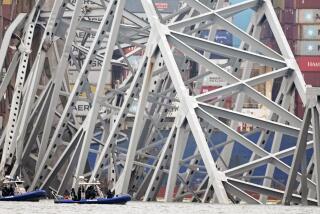Site Raises Health Concerns
- Share via
NEW YORK — The scent of death mixed with the dust rising from the cold, damp sump of the ruined World Trade Center, overtaxing the cadaver dogs nosing the rubble for human remains and stirring fears of public health hazards in weeks to come.
Medical authorities and public health experts Saturday discounted the risk of a major epidemic or serious disease outbreak in New York, but warned that medical dangers and emotional hazards for rescue workers will only worsen as buried bodies decay.
Medical experts are contending not just with the risk of virulent infections from rotting bodies. They must also guard against the possibility that the wreckage may have been sown with lethal microbes as an additional act of terrorism. That fear, at least, is rapidly fading as the days wear on with no sign of an outbreak, several medical forensic experts said.
“We would have known by now if there were any potential biotoxins or chemical toxins left by the hijackers of the planes in canisters or whatever with time releases,” said medical forensic expert Dr. Cyril H. Wecht, chair of the department of pathology at the Central Medical Center and Hospital in Pittsburgh.
But other fears linger.
So much blood may have been spilled by casualties in the collapse of the two 110-story towers Tuesday that the risk of HIV contamination, while low, must be considered, urban search and rescue officials in Los Angeles and New York said. The raw sewage from broken building pipes also heightens the risk of infections, several disaster relief experts said.
Even so, many workers ignored pleas to wear masks or take other precautions as they searched for any trace of the 4,972 people still unaccounted for after Tuesday’s terrorist attack.
By late Saturday, 152 bodies and 400 body parts had been recovered, officials said.
Only 20,000 tons of the skyscrapers’ estimated 1.25 million tons of debris has been removed so far.
Baked for days in the hot sun, soaked by rain and now chilled by autumnal breezes, the wreckage of the World Trade Center has become a giant petri dish for potential contagions, public health experts said. But the ready availability of major hospitals, trained medical personnel and potable water makes the actual risk of any outbreak remote.
“The primary concern that people have is whether or not the unburied remains are going to pose a danger of an epidemic of infectious disease,” said Dr. Steven Rottman, director of UCLA’s Center for Public Health and Disaster Relief. “The experience [in other major disasters] has been that they do not pose any danger of an epidemic.”
To better monitor potential contagions, however, the U.S. Centers for Disease Control and Prevention in Atlanta sent 34 public health experts to New York. They join the cadre of state, city and other federal health experts gathered here from around the country. A CDC specialist will be posted at each major hospital in the city.
In a formal medical alert, the CDC reminded hospital authorities that human remains from explosions and collapsed buildings do not by themselves pose a risk of disease epidemics. But the agency warned hospital workers that they should use standard precautions when handling the remains because of bacteria.
As the days of searching for bodies turn into weeks and months, the psychological scars could become crippling.
“It is going to become very very unpleasant,” said Rottman. Already, it is more than some can bear.
Canine handler Richard Clark, a volunteer from Southhaven, Miss., searched the wreckage for human remains with his Border Collie, Sam, who is trained to locate people buried in debris. In 36 hours of work, man and dog helped locate remains at 17 spots in the rubble.
Then, Clark said, “I found a child’s arm . . . part of a hand. I just lost control of myself.
“I never trained to do body parts,” Clark said. “There is nothing in the manual about looking for parts of 5,000 people.”
*
Times staff writer Charles Ornstein contributed to this report.
More to Read
Sign up for Essential California
The most important California stories and recommendations in your inbox every morning.
You may occasionally receive promotional content from the Los Angeles Times.













